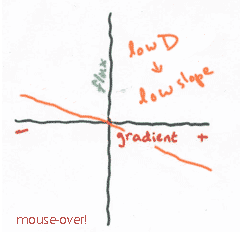Graphing Fick's First Law
We know that the equations describing Fick's First Law are analagous to the general equation for a straight line with a negative slope that intersects the origin (y = -mx), and you should already have a pretty good idea of what the graph of this relationship will look like (the continuous version is below, but the discrete version would look exactly the same!).
 |
 |
In this case, the dependent variable is flux, and the independent variable dC/dx). Remember, dC/dx only looks scary. In reality it is just a notation for "the gradient".
But what is the biological meaning of the slope of the relationship in Fick's First Law? Or, put another way, how is the driving force (the gradient) translated into a response (flux)? As we mentioned earlier, the proportionality constant in the equation gets its own name, D(called the diffusion coefficient).The actual value of D is not given by Fick’s Law but is something that needs to be measured, and it is different for each unique situation (a particular molecule in a particular medium at a particular temperature). For example, the diffusion coefficient of oxygen in water is a consistent value at room temperature, but if you heat up the water, D goes up – the oxygen diffuses faster when the temperature is higher, or if you substitute molasses for water, D goes down – oxygen has a hard time diffusing through molasses (and so would you!). If a larger molecule (say, a protein) is diffusing through water, D will go down again, since big molecules move less and therefore diffuse more slowly than small ones.
So what happens to the flux vs gradient graph if the diffusion coefficient changes? According to Fick's First Law, these quantities are directly proportional to each other (remember the function is like y = mx) and -D is the slope. If you are interested in the diffusion of glucose instead of oxygen, you get a different diffusion coefficient D, and so the line has a different slope. In other words, when D is high, the same gradient causes more diffusion and when D is low, the same gradient causes less diffusion.
Copyright University of Maryland, 2007
You may link to this site for educational purposes.
Please do not copy without permission
requests/questions/feedback email: mathbench@umd.edu
